Menus
- Ten years after
- The generational difference is expressed purely optically
- Yamaha MT-10 got the cream parts of the R1 donated
- The chassis of the Yamaha FZ1 is weaker in comparison
- Disillusionment looking at the performance graph
- What about braking??
- Conventional inline four-cylinder vs. Crossplane
- Technical specifications
- MOTORCYCLE conclusion
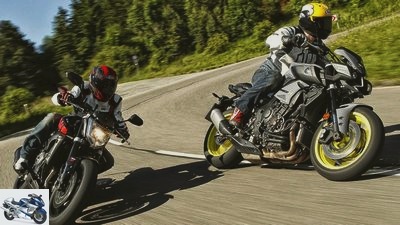
www.bilski-fotografie.de
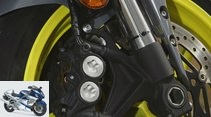
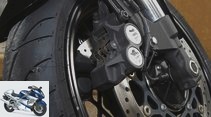
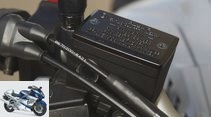

21st photos
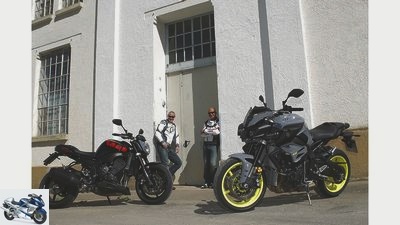
www.bilski-fotografie.de
1/21
There is joy. Dynamic country road burners with great chassis.
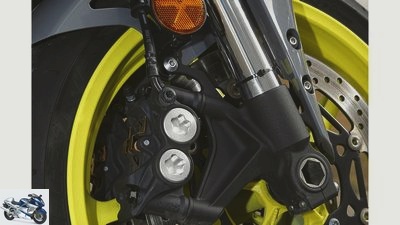
www.bilski-fotografie.de
2/21
Both have the characteristic screwed-in cover over the brake piston…
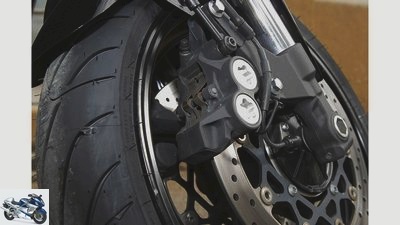
www.bilski-fotografie.de
3/21
…Radially screwed pliers on the other hand only the Yamaha MT-10 (in the picture you can see the Yamaha FZ1).
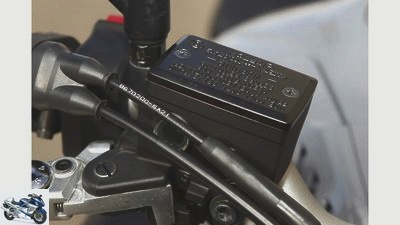
www.bilski-fotografie.de
4/21
Both have to be satisfied with conventional brake pumps with a molded expansion tank.

www.bilski-fotografie.de
5/21
With slight advantages in terms of bite and dosage for the Yamaha FZ1.

www.bilski-fotografie.de
6/21
In contrast to the Yamaha MT-10, the Yamaha FZ1 did not have the noble spring elements of the R1 at that time.

www.bilski-fotografie.de
7/21
With her, the tension and compression stages are separated according to Holmen.

www.bilski-fotografie.de
8/21
Cockpit with racing dashboard optics and a lot of information on the Yamaha MT-10 – including a highly progressive fuel gauge.
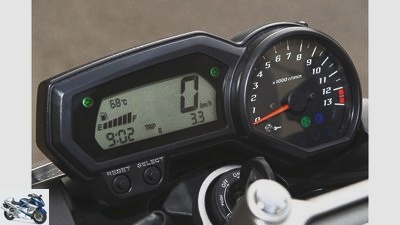
www.bilski-fotografie.de
9/21
The Yamaha FZ1 only has the most necessary information ready.
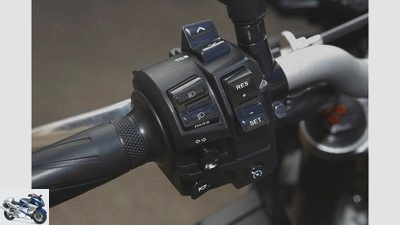
www.bilski-fotografie.de
10/21
Operating the cockpit from the handlebars is the state of the art today.

www.bilski-fotografie.de
11/21
Ten years ago it was the operation of lights, horns and indicators.
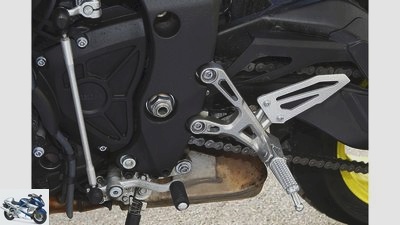
www.bilski-fotografie.de
12/21
Overlying gear shafts and vertical shift linkage; filigree, handy notches.
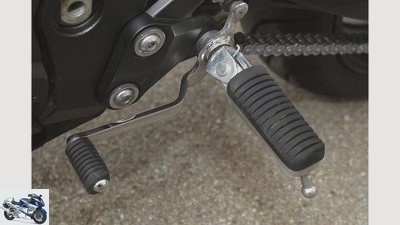
www.bilski-fotografie.de
13/21
The Yamaha FZ1 had its rather coarse, bulky pegs mounted in rubber.

www.bilski-fotografie.de
14/21
Mighty swing arm axis of the MT compared to the FZ axis…
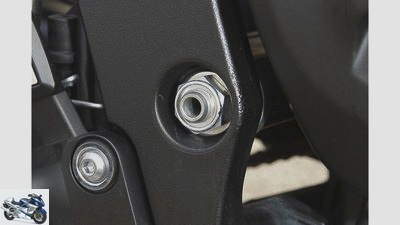
www.bilski-fotografie.de
15/21
…as a result of striving for a lot of stability in the area of the swing arm mounting.
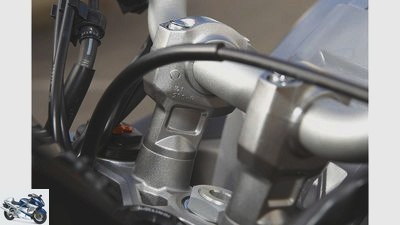
www.bilski-fotografie.de
16/21
Here and now: rigidly screwed handlebar brackets with butted aluminum handlebars on the Yamaha MT-10 for a direct steering feel.
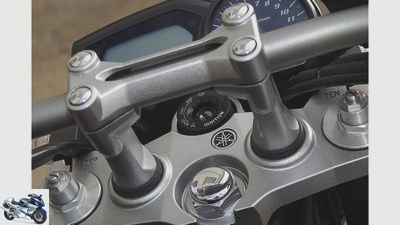
www.bilski-fotografie.de
17/21
The FZ carried its handlebar brackets in rubber to reduce vibration.

www.bilski-fotografie.de
18/21
Country roads are their territory, but the Yamaha FZ1 can only keep ahead of the Yamaha MT-10 in this picture.
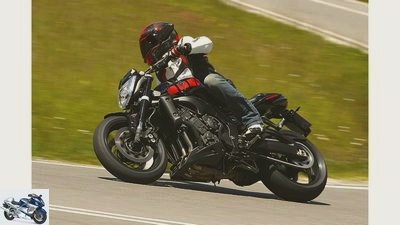
www.bilski-fotografie.de
19/21
Yamaha FZ1.
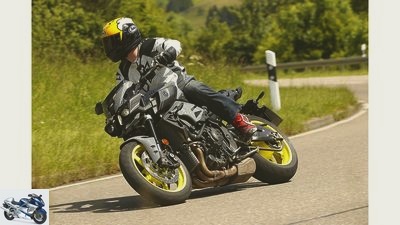
www.bilski-fotografie.de
20/21
Yamaha MT-10.
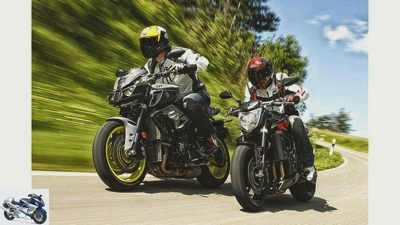
www.bilski-fotografie.de
21/21
The Yamaha MT-10 consistently continues the path that the Yamaha FZ1 once took.
Yamaha FZ1 and Yamaha MT-10 in comparison test
Ten years after
In 2006 the Yamaha FZ1 took the stage. Not a soft-washed naked bike, a naked athlete. Now the successor is ready with the Yamaha MT-10. Visually they separate worlds, technically a lot has happened. Is the MT-10 ready to hand over the baton??
Jens grins. Has fought for pole position on the key board and the key of the Yamaha MT-10 for the ride with the Yamaha FZ1 secured. Sure, the attraction of the new. Chassis from Superbike R1, engine too. Just with more torque and still a hefty 160 hp. In addition, a sitting position suitable for street fighting. The FZ1, which will be replaced by the MT-10, was launched with this recipe exactly ten years ago. That means from now on 160 instead of 150 HP, 111 instead of 106 Newton meters, 223 instead of 230 kilos. Plus the latest electronics, ride-by-wire, driving modes and traction control.
Buy complete article

Yamaha FZ1 and Yamaha MT-10 in comparison test
Ten years after
FZ1 – last list price 11,750 euros – already sold for well below 10,000. Less than when the keel was laid in 2006. The Yamaha MT-10 costs 12,995 euros. And for the price difference of around 3,000 euros, there are a few nice accessories.
The generational difference is expressed purely optically
Crouching forward with clear, classic lines, the engine nicely staged, the Yamaha FZ1. Grim, almost menacing, rugged and technocratic, the Yamaha MT-10. In any case, the seat test clearly decides the MT for itself. Jens is beaming for the second time. Has placed its almost two meters length comfortably in her saddle. Sits really relaxed. Some colleagues sometimes used the title “passive”, but it is definitely more harmonious than the seating on the FZ1. The builders weren’t so lucky when it came to designing them.
Even if the Yamaha MT-10 is not as wonderfully narrow in the knee area as its gene donor R1, the tank of the Yamaha FZ1 spreads the rider’s knees much more widely. In addition, their notches are higher and further forward, which in connection with the handlebars cranked towards the driver and the low seat height results in a compact, but somewhat idiosyncratic mixture.
www.bilski-fotografie.de
The MT-10 consistently continues the path that the FZ1 once took.
The sound check also goes to the Yamaha MT-10. The muffled rumble of the crossplane engine just creeps in flatteringly in your ear. With its crank pin offset of 90 degrees (see "The big bang") it inimitably imitates a V4. The hearty roaring at high speeds included. The FZ can still grumble as much or start the typical four-cylinder howl at higher speeds. The MT sound gets under your skin. But on the first few kilometers out of the big city juggernaut, FC still collects sympathy points. When starting, it comes from the clutch a little more forcefully, which is also more finely dosed. The FZ also reacts much more sensitively to small steering movements than the MT-10 with its steering damper. So you can sneak out of the city in a well-dosed way. But only to the end of the town. The noble reluctance is over there. Throttle on draft – let’s go. And Jens stays the spit away for now. Because the FZ1 in front of him hits the twisted road like a hare. A short stop, a machine change – and a few kilometers later it gushes out from under Jens ’helmet:” It’s unbelievable how the Yamaha FZ1 falls into the bends. “
That’s right, although it wasn’t actually known for daring handling. But she suffered from her first tires with rather old-fashioned Dunlop D 221s. That is why we have kindly strapped her brand new Dunlop Roadsmart 3 onto the rims. And so the Yamaha FZ1 really zigzagging in an inclined position, can be peppered almost without will from left to right. Only from medium lean angles does some counter pressure build up on the handlebars. It takes a little getting used to, but then it’s a force. Perhaps a little too much of a good thing, but it shows that with the right tires, the rather painfully steerable FZ can really make its legs and in terms of handling it can be brought on par with the Yamaha MT-10. It hardly seems less agile, but more certain when turning, more serene, more concentrated when choosing lines.
Yamaha MT-10 got the cream parts of the R1 donated
How times change When they first appeared in the top test in 2006, the testers complained about the FZ1’s suspension setting being too tight and the less sensitive work of the suspension elements. Maybe today, ten years later, we are used to harder things. See the hindquarters of the Yamaha MT-10. But the chassis tuning of the Yamaha FZ1 can actually pass as a good compromise between sporty, firm and comfortable damping. Only the thing about the response is still true. Especially when you have a creamy fork like the MT-10 with you as a comparison. On the other hand, your shock absorber rumble more recently over short, hard joints and bumps.
The MT pilot is rewarded with unbelievable stability even in lightning-fast bends, whether riddled with bumps or not. The Yamaha MT-10 doesn’t matter. It is stable as a bolt and pulls its course cleanly. This is the reward for the fact that Yamaha did not skimp on the suspension elements as it did with the Yamaha FZ1. The noble damper goods of the R1 were denied at the time. The rebound and compression stages sit separately in a fork leg, and the shock absorber does not have a reservoir or adjustable compression stage. The MT, on the other hand, got the cream of the crop from the R1, including high and low-speed compression on the shock absorber.
The chassis of the Yamaha FZ1 is weaker in comparison
Basically, the Yamaha FZ1 also masters cool cornering without complaint, only there is always a little more movement in the chassis, it is not quite as earthy. And where Jens casually angles the MT further and further in turns, the author is already pulling furrows in the road with the notches of the FZ. The point of lean angle clearly goes to MT. In terms of chassis, the new construction of the Yamaha MT-10 stands out. She appears fuller, more confident, more concentrated.
Nevertheless, Jens ponders when he takes turns on our test track. “Say, get out of the hairpin bends, do you drive in the second or third? The Yamaha FZ1 is a beast. ”Don’t worry Jens, I’ll take the FZ out of the turns in the second. In the third, you’d probably bump into my rear.
www.bilski-fotografie.de
There is joy. Dynamic country road burners with great chassis.
Which brings us to the engine. It caused long faces when the Yamaha FZ1 was released. The technicians had taken a good 25 hp from the R1 engine in accordance with its intended use, but hardly breathed any more pressure into it. And combined the whole thing with the racing-style gearbox with a long first gear of the R1 and a very long overall ratio. The bottom line was that the FZ1 engine’s penetrating power was in the first half of its speed range, well, let’s say, at the lower end of its class.
Accordingly, a hard-working gearshift is required for brisk progress. And don’t be afraid of high speeds. The Yamaha FZ1 only flexes its muscles properly from 7000 rpm. She loves and needs speed. She does not come on velvet paws. Noticeable vibrations accompany the march through the speed range.
Disillusionment looking at the performance graph
The MT drive is cut from a different cloth. But first of all, disillusionment spreads when you look at the performance diagram. Where is the progress of ten years? The two curves are almost congruent. In practice, the MT still boils off its predecessor. Even though Yamaha achieves this mainly with quite mundane means, namely a significantly shorter overall gear ratio. The draft values speak volumes. In the last gear, the MT of the FZ decreases from 60 to 100 km / h for almost a second. Until 140 again. From 140 to 180 there are almost two. In addition, the Yamaha MT-10 hangs much more directly on the gas, responding to commands from the right hand immediately with propulsion. This makes it appear much more lively and agile, turns more light-footed upwards and runs much more smoothly. Whereby the low-frequency rumble of the crossplane motor always conveys less speed than is currently applied. As a result, you often catch yourself squeezing the engine to the highest positions, simply leaving the gear in there. While the Yamaha FZ1 screaming at five-digit speeds encourages you to step into the next gear.
Nevertheless, with the more powerful MT curves, Jens almost always takes a gear higher than the author on the FZ and still hangs full-format in his rear-view mirrors. Logical, Jens can also pull the cable uninhibitedly at the exit of a curve, after all, when things get tricky, the traction control switches on. At the gentlest level, this also brings a rising front wheel back down to earth. In any case, the MT with its temperament tears it on the rear wheel faster than the FZ. Traction control? It has to fit there – and finally let the Yamaha MT-10 pass by. The MT motor simply presses more vigorously, turns like a prick, and the Yamaha FZ1 cannot counter it.
What about braking??
On the other hand, when braking. Cannon fodder on the brakes? The Yamaha FZ1 certainly isn’t. On the contrary. Your brake grabs more spontaneously and more forcefully. Can be dosed more finely, its pressure point a little more present – although “only” equipped with conventionally screwed brake calipers. Radial brake pump? Nothing in both. Yes, the red pencil. But Jens made it on the next straight, pulling past with a throaty roaring MT. Just to turn to the gas pump in the next town. The Yamaha MT-10 is not only ahead in terms of performance. Even when thirsty. With 6.8, it allows itself a good liter more per 100 kilometers than the FZ and has sucked the tank empty after around 250 kilometers. The “Eco” display in the cockpit almost has something of real satire when driving cautiously. Speaking of the cockpit. With displays for gear, outside temperature and consumption, plus the selected engine mapping, it is much more informative than that of the FZ, which basically only provides the most necessary information. Here, too, time has not stood still.
Ultimately, the Yamaha FZ1 also has to acknowledge this. “With a shorter translation, the FZ1 might be with the music”, Jens muses, pulls on his helmet and swings into the saddle of the MT-10. “And a pillion passenger can at least find a reasonably acceptable spot,” I add. But nothing helps, the Yamaha MT-10 is the more modern, ultimately better sharpening iron. And Jens has every reason to grin.
Conventional inline four-cylinder vs. Crossplane
This is the difference between a conventional inline four-cylinder (180 degree offset) and a crossplane engine (90 degree offset).
Big Bang, Screamer, Crossplane. A conventional inline four-cylinder ignites uniformly every 180 degrees of crankshaft rotation due to its 180 degree crank pin offset. This gives it the typical screaming sound at high speeds. In the case of the crossplane engine, with its crank pins offset by 90 degrees, the engine runs with uneven ignition intervals.
The first ignition is followed by a three-quarters crankshaft revolution pause, second ignition, half-turn pause, third ignition, quarter turn pause, fourth ignition. Which basically corresponds to a 90 degree V4 with a 180 degree crankpin offset. In theory, this should have a positive effect on traction in racing. However, no torque advantages can be identified with this design. The sound is also a pleasure in everyday life.
Technical specifications
www.bilski-fotografie.de
The Yamaha FZ1 carried its handlebar brackets in rubber to reduce vibrations.
Here you can see an extract of the technical data. If you would like the complete measurement values determined by us, including all consumption, torque and acceleration values, you can buy the article as a PDF for download.
MOTORCYCLE conclusion
www.bilski-fotografie.de
The Yamaha MT-10 inherits the Yamaha FZ1.
It is more agile and precise. It’s more stable and it’s stronger. Especially when starting out. Even if the Yamaha MT-10 benefits more from its short gear ratio than from bull-necked torque. It consistently continues the path that the Yamaha FZ1 once took. That of a dynamic, undisguised athlete for the country road. The handover was successful.
Related articles
-
Yamaha MT-10 in the driving report
markus-jahn.com 15 pictures markus-jahn.com 1/15 The Yamaha MT-10 is based closely on the R1 with its fantastic chassis. Yamaha 2/15 Sporty …
-
Aprilia Tuono V4 1100 Factory and Yamaha MT-10 in comparison test
Bilski 21st photos www.bilski-fotografie.de 1/21 Nordschleife comparison with the Aprilia Tuono V4 1100 Factory and Yamaha MT-10….
-
Comparison test of 400 sports enduros
Comparison test of 400 sports enduros Master hunter With the 400 EXC, KTM took the Enduro World Championship title last year. The Euro-Fighter for 2000…
-
Jorg Kunstle Top test Yamaha FZ1 / Fazer Let’s start now? We had to wait a long time for that: a naked Nippon athlete. Not rinsed soft, but light, firm…
-
2017 super sports car in the country road comparison test
fact 28 photos factstudio.de 1/28 The 2017 superbikes were just battling it out on the racetrack, now the focus is on the country road, everyday…
-
Comparison test of the 600 super sports car
Comparison test of the 600 super sports car It’s getting tight Riot in the sports group. A whopping 124 hp, a ridiculous 207 kilograms with a full tank,…
-
Comparison test Suzuki SV 650, Honda CB 650 F, Kawasaki ER-6n, Yamaha MT-07
www.bilski-fotografie.de 34 photos www.bilski-fotografie.de 1/34 They are the hottest contenders among the mid-range naked bikes….
-
Comparison test of sporty enduros
Comparison test, KTM 620 LC 4, Suzuki DR 650 SE, Triumph TT 600 Sporty enduros Too good for tough sports use and too rough for everyday life: KTM 620 LC4…
-
Comparison test Honda CB 1300 S, Suzuki Bandit 1200 S, Yamaha FZ1 Fazer
Bilski Comparison test Honda CB 1300 S, Suzuki Bandit 1200 S, Yamaha FZ1 Fazer Search for clues They share their sporting roots. At Honda in terms of…
-
Comparison test Harley-Davidson Fat Boy, Kawasaki 1500 VN, Yamaha XVZ 1300 A
Comparison test, Harley-Davidson Fat Boy, Kawasaki VN 1500 Classic, Yamaha XVZ 1300 A Royal Star Harley-Davidson Fat Boy, Kawasaki 1500 VN, Yamaha XVZ…
This is one of the most poorly written most difficult to read articles i’ve ever come across. Yes all the info’s there it’s just put together so badly.